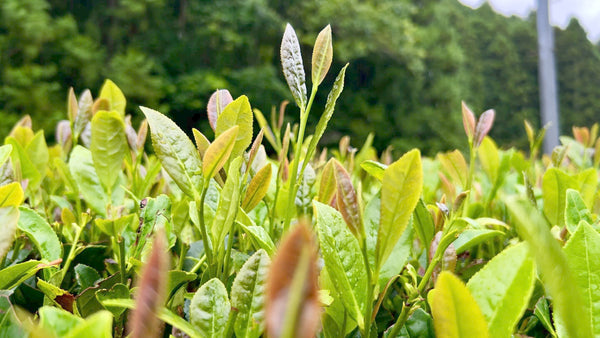Green tea
To make green tea, fresh buds and young leaves are picked in early spring, which have barely oxidized during processing (0-5%), retaining their green color.
An important criterion for them is a bright green, in the case of Chinese teas a very slightly yellowish-green color, which also indicates their freshness. If your tea has a brownish tint, it is probably old or has been stored improperly. After the fresh shoots are picked, the leaves are heat-treated to stop the browning and oxidation.

We find finished green tea in countless, varied forms (twisted, flattened, etc.).
The method of preparation and the shape of the tea depend on the region of the tea plantation and local traditions. In China, it is also very important that the shape of the finished tea leaves is beautiful and spectacular.
Let's go back a bit to oxidation, which is one of the main differences between tea types.
There are two ways to stop the oxidation (browning of leaves) caused by enzymes: by baking or steaming.
Depending on the type of tea being made, the leaves may or may not be allowed to oxidize.
Chinese greens - fried, Japanese greens steamed
This is a pretty crude statement, but we can say that it is one of the main differences between the tea of the two nations. :-)
Roasted teas are typically Chinese or Vietnamese greens,
and Korean and Japanese green teas were steamed .
The frying process in a wok is a little slower, so the finished Chinese green teas may have a very slight yellowish-greenish tint.
Their taste is sweet, toasted and seeded, while Japanese steamed green teas have a more spinachy, grassy, much greener taste.
We made Long Jing (Dragon Well) tea, picked from Mr. Lin's tea garden in the morning and processed under his supervision.
It is also important to know that this type of tea, regardless of which Asian country it comes from, retains its freshness and refreshing taste for a maximum of one year.
Like rosé wine, it is advisable to consume the greens you buy in the given year.
Steaming also stops the oxidation of the leaves used to make matcha tea. Shaded tea leaves are used to make matcha tea to increase the chlorophyll content.
In our tea room, we always store our non-oxidized teas and matcha tea refrigerated or frozen so that you can always taste fresh tea.
Making green tea - How to make delicious tea?
We recommend preparing Chinese teas with water between 70 and 80 degrees , with a steeping time of about 40 seconds. We will explain the preparation of Japanese teas in more detail later .
Use soft water with low mineral content, good tasting spring or filtered water. Avoid chlorinated tap water, as it will not make the tea taste good.
It is practical to use glass tea making utensils, as they allow you to see the tea leaves clearly and do not keep the temperature high for as long as clay pots.
What types of green tea are there?
There are two main types: roasted and steamed. Roasted teas are typically Vietnamese or Chinese green teas, while steamed teas are Korean and Japanese green teas.
How much caffeine does green tea contain?
It is a type of tea that is richer in caffeine, but you should know that it has a completely different effect than the caffeine in coffee. It also contains other substances and vitamins, plus the well-known theanine, which can bring us a pleasant alert calm. Of course, it affects everyone differently, so it is worth monitoring how we react when consuming it.
What exactly is the difference between green tea fiber and green tea powder?
Loose green tea contains roasted or steamed leaves in their whole form, beautifully preserving the fresh spring shoots. Green tea powder contains leaves that have been ground into a powder. This is not the same as matcha! Green tea powder is a separate category, here the leaf veins are also included in the grind and is not consumed ceremonially.
Try steeping in cold water (mizudashi)! You will get a soft, sweet, refreshing drink. Use 8 grams of tea leaves for 1200 ml of room temperature water. Put it in the refrigerator overnight, then strain the entire drink the next day and you can drink it.
It is recommended to constantly refrigerate the drink prepared in this way to prevent it from turning brown prematurely or changing its taste.
It is a type of tea that is richer in caffeine, so it is better to drink it in the morning, but it can definitely be drunk after meals, on an empty stomach.
Health effects of green tea
For those who like the findings of scientific research, I have included the photo on "Health Effects" taken in April 2019 at the Hangzhou Tea Museum, for your further use.
From this perspective, we can examine 4 different water-soluble components: catechins, theanine, caffeine, and vitamins.
Catechins are attributed to the healthiest effects of tea: they are effective cell regenerators and antioxidants . 1/3 of the leaf contains them and the plant produces them from its own proteins with the help of sunlight.
(This is why shaded teas have fewer catechins, but sencha is not shaded "by default").
In terms of taste, this substance is no longer so popular, as it is a bitter, astringent, and drying compound.
It's worth looking into Epigallocatechin (EGCG) - if you're interested in more: https://www.ncbi.nlm.nih.gov/pmc/articles/PMC2748751/
Theanine, especially L-Theanine , is an amino acid found in 1-4% of the leaf (shaded teas have more of it).
A sweet, "umami" flavor adds richness to the drink and also has a natural calming effect.
Caffeine: It is found in 3-4% of the leaf. Green tea contains the same caffeine molecule as black tea or, for example, coffee, but it is in a different bond, so it is absorbed more slowly and more evenly from green tea.
However, there can be large individual differences in how this affects someone.
Vitamins: We can find vitamins A, B, C, and E in smaller amounts, of which vitamin C is the most abundant.
A few of its effects can be seen in the photo, the rest can be read. You can find scientific articles on this here.
- It has a high antioxidant content and free radical scavenging effect.
- protects against viral and bacterial infections
- supports blood pressure
- strengthens the immune system
- lowers cholesterol levels
It is also worth observing its effect on us.
A type of tea known by everyone as a healthy drink, it is not for everyone.
For those who are usually cold-hearted (like Dóri :)) and cannot tolerate raw foods, green tea can also be stressful and we can quickly start to feel cold after drinking it, and our hands may become cold.
"I save green tea for the hot summer months, as it has an excellent cooling and refreshing effect on the body. In cooler weather, I drink matcha tea more often, then after a while I drink a cup of hojicha tea, which warms my body back up."
Balázs often drinks the greener type, and it is very beneficial for his fiery, yang energy.
In short, pay attention to your body, how it reacts to tea and don't believe everything you read, experience it yourself!" - Dóri
Black or green tea? What's the difference and what's the similarity?
The similarity between the two types of tea is that they are made from the Camellia Sinensis tea plant, or one of its variants. The variant is none other than the Gala, Jonathan, Granny Smith, etc. apple variants or varieties.
The difference between them is their oxidation level. If you cut an apple in half, it turns brown in the air. This also happens with black tea, the leaves turn completely brown, they are oxidized. This does not happen with green tea because it is immediately heat-treated, thus preserving its freshness.
If you have "green tea" at home that has a yellowish, brownish, or dull green color, it has definitely oxidized, so it may be old or not stored properly.




